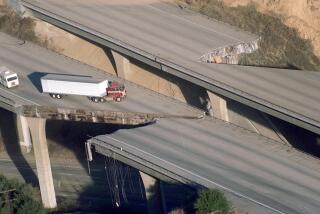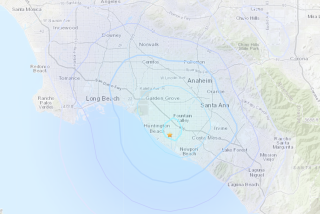Checking a nuclear fault line
The Diablo Canyon nuclear plant has more than 12 years to go before the licenses for its two reactors expire. There’s plenty of time for its owner, Pacific Gas and Electric Co., to conduct a new seismic safety study. That’s all the more important after the Japanese earthquake showed that seismic faults can throw off bigger jolts than geologists expected. And it is imperative after the U.S. Geological Survey found a previously unknown fault along the central California coast, near the plant.
How near is the Shoreline fault? No one knows exactly, which is partly the point. The fault was found through the mapping of clusters of smaller earthquakes. According to state Sen. Sam Blakeslee (R-San Luis Obispo), who has a doctoral degree in earthquake science and whose district includes Diablo Canyon, the fault could be half a mile away, or a few hundred yards, or under the reactors. The California Energy Commission has recommended a three-dimensional imaging study — a sort of geological CT scan — to determine the precise location of the Shoreline Fault and learn more about it.
In October 2008, a PG&E representative told the Energy Commission that the company believed there was “no uncertainty regarding the seismic setting and hazard at the Diablo Canyon site.” A month later, the USGS announced that it had found the new fault, but even then the company resisted the three-dimensional study. Its stance has softened under repeated recent attacks; in mid-March, PG&E said it was considering further study, and in late March, it said it would seek permits for the 3-D study. But although Blakeslee has called on the company to withdraw its pending application for a 20-year license renewal until the study is completed, the company has not committed to doing so.
The U.S. Nuclear Regulatory Commission, which licenses reactors, shouldn’t act on the application until the study has been completed. State agencies such as the Public Utilities Commission and Energy Commission, which are responsible for ancillary regulation of the plant, should back that up with a similar response. And all new studies should be subject to independent oversight and peer review. Those same requirements should apply to the San Onofre Nuclear Generating Station, whose majority owner, Southern California Edison, last week proposed new seismic studies.
As delighted as we would be if nuclear power were the clean, safe answer to this country’s need for oil independence and a stable energy supply, our position is that the dangers outweigh the benefits. The nation’s future lies in sustainable energy sources, not in nuclear. The decommissioning of today’s nuclear plants, though, is far off. In the meantime, the minimum requirement should be complete study of seismic risks in order to protect California’s coast.
More to Read
A cure for the common opinion
Get thought-provoking perspectives with our weekly newsletter.
You may occasionally receive promotional content from the Los Angeles Times.






